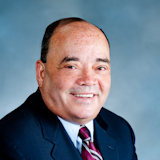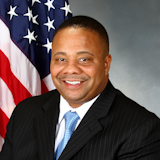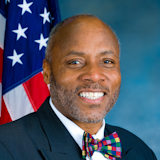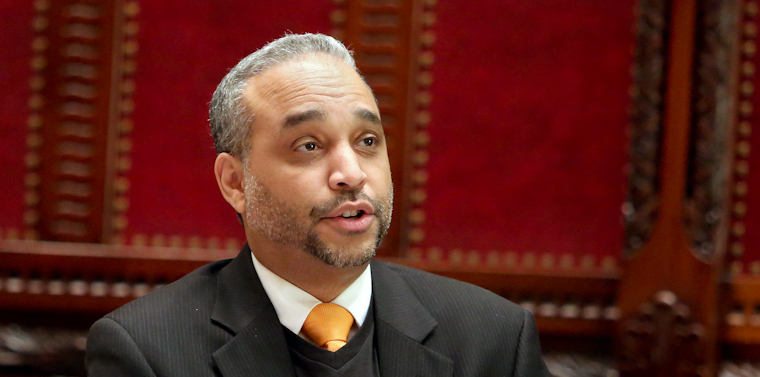| Date of Action |
Assembly Actions -
Lowercase Senate Actions - UPPERCASE |
|---|---|
| Apr 13, 2016 |
print number 3256b |
| Apr 13, 2016 |
amend and recommit to finance |
| Jan 15, 2016 |
print number 3256a |
| Jan 15, 2016 |
amend (t) and recommit to finance |
| Jan 06, 2016 |
referred to finance |
| Feb 04, 2015 |
referred to finance |
Senate Bill S3256B
2015-2016 Legislative Session
Sponsored By
(D) 10th Senate District
Archive: Last Bill Status - In Senate Committee Finance Committee
Actions
Bill Amendments
co-Sponsors
(D) Senate District
2015-S3256 - Details
- Current Committee:
- Senate Finance
- Law Section:
- Appropriations
- Laws Affected:
- Amd §365, Soc Serv L; add Art 31 Title IV §3126, Pub Health L
- Versions Introduced in Other Legislative Sessions:
-
2013-2014:
S6239
2017-2018: S4054
2019-2020: S2281
2015-S3256 - Sponsor Memo
BILL NUMBER:S3256
TITLE OF BILL: An act to amend the social services law and the public
health law, in relation to establishing the sickle cell treatment act
of 2015; and making an appropriation therefor
PURPOSE: To include primary and secondary preventative medical
strategies, treatment, and services, including genetic counseling and
testing, for individuals who have Sickle Cell Disease in the City of
New York and for no more than five counties.
SUMMARY OF PROVISIONS:
Section 1 of the bill names the bill the Sickle Cell Treatment Act of
2014.
Section 2 of the bill outlines what Sickle Cell Disease is, how it is
an inherited disease and the number of people afflicted.
Section 3 of the bill amends Section 36.5 of social services law by
adding a new subdivision number 13. New subdivision 13 provides that
the health Department shall be responsible for furnishing medical
assistance and counseling for prevention of the spread of sickle cell
disease and medical services for eligible individuals who are
afflicted with sickle cell disease.
2015-S3256 - Bill Text download pdf
S T A T E O F N E W Y O R K
________________________________________________________________________
3256
2015-2016 Regular Sessions
I N S E N A T E
February 4, 2015
___________
Introduced by Sen. SANDERS -- read twice and ordered printed, and when
printed to be committed to the Committee on Finance
AN ACT to amend the social services law and the public health law, in
relation to establishing the sickle cell treatment act of 2015; and
making an appropriation therefor
THE PEOPLE OF THE STATE OF NEW YORK, REPRESENTED IN SENATE AND ASSEM-
BLY, DO ENACT AS FOLLOWS:
Section 1. This act shall be known and may be cited as the "sickle
cell treatment act of 2015".
S 2. Legislative findings. The legislature hereby finds and declares
the following:
(1) Sickle cell disease (SCD) is an inherited disease of red blood
cells that is a major health problem in the United States.
(2) Approximately 100,000 Americans have SCD and approximately 1,000
American babies are born with the disease each year. SCD also is a
global problem with close to 500,000 babies born annually with the
disease.
(3) In the United States, SCD is most common in African-Americans and
in those of Hispanic, Mediterranean, and Middle Eastern ancestry. Among
newborn American infants, SCD occurs in approximately 1 in 500 African-
Americans, 1 in 36,000 Hispanics, and 1 in 80,000 Caucasians.
(4) More than 3,000,000 Americans, mostly African-Americans, have the
sickle cell trait. These Americans are healthy carriers of the sickle
cell gene who have inherited the normal hemoglobin gene from one parent
and the sickle cell gene from the other parent. A sickle cell trait is
not a disease, but when both parents have the sickle cell trait, there
is a 1 in 4 chance with each pregnancy that the child will be born with
SCD.
(5) Children with SCD may exhibit frequent pain episodes, entrapment
of blood within the spleen, severe anemia, acute lung complications
(acute chest syndrome), and priapism. During episodes of severe pain,
EXPLANATION--Matter in ITALICS (underscored) is new; matter in brackets
[ ] is old law to be omitted.
LBD04153-01-5
co-Sponsors
(D) Senate District
(D) Senate District
(D, WF) Senate District
(D) Senate District
2015-S3256A - Details
- Current Committee:
- Senate Finance
- Law Section:
- Appropriations
- Laws Affected:
- Amd §365, Soc Serv L; add Art 31 Title IV §3126, Pub Health L
- Versions Introduced in Other Legislative Sessions:
-
2013-2014:
S6239
2017-2018: S4054
2019-2020: S2281
2015-S3256A - Sponsor Memo
BILL NUMBER: S3256A
TITLE OF BILL :
An act to amend the social services law and the public health law, in
relation to establishing the sickle cell treatment act of 2016; and
making an appropriation therefor
PURPOSE :
To include primary and secondary preventative medical strategies,
treatment, and services, including genetic counseling and testing, for
individuals who have Sickle Cell Disease in the City of New York and
for no more than five counties.
SUMMARY OF PROVISIONS :
Section 1 of the bill names the bill the Sickle Cell Treatment Act of
2016.
Section 2 of the bill outlines what Sickle Cell Disease is, how it is
an inherited disease and the number of people afflicted.
Section 3 of the bill amends Section 36.5 of social services law by
adding a new subdivision number 13. New subdivision 13 provides that
the health Department shall be responsible for furnishing medical
2015-S3256A - Bill Text download pdf
S T A T E O F N E W Y O R K
________________________________________________________________________
3256--A
2015-2016 Regular Sessions
I N S E N A T E
February 4, 2015
___________
Introduced by Sens. SANDERS, DILAN -- read twice and ordered printed,
and when printed to be committed to the Committee on Finance -- recom-
mitted to the Committee on Finance in accordance with Senate Rule 6,
sec. 8 -- committee discharged, bill amended, ordered reprinted as
amended and recommitted to said committee
AN ACT to amend the social services law and the public health law, in
relation to establishing the sickle cell treatment act of 2016; and
making an appropriation therefor
THE PEOPLE OF THE STATE OF NEW YORK, REPRESENTED IN SENATE AND ASSEM-
BLY, DO ENACT AS FOLLOWS:
Section 1. This act shall be known and may be cited as the "sickle
cell treatment act of 2016".
S 2. Legislative findings. The legislature hereby finds and declares
the following:
(1) Sickle cell disease (SCD) is an inherited disease of red blood
cells that is a major health problem in the United States.
(2) Approximately 100,000 Americans have SCD and approximately 1,000
American babies are born with the disease each year. SCD also is a
global problem with close to 500,000 babies born annually with the
disease.
(3) In the United States, SCD is most common in African-Americans and
in those of Hispanic, Mediterranean, and Middle Eastern ancestry. Among
newborn American infants, SCD occurs in approximately 1 in 500 African-
Americans, 1 in 36,000 Hispanics, and 1 in 80,000 Caucasians.
(4) More than 3,000,000 Americans, mostly African-Americans, have the
sickle cell trait. These Americans are healthy carriers of the sickle
cell gene who have inherited the normal hemoglobin gene from one parent
and the sickle cell gene from the other parent. A sickle cell trait is
not a disease, but when both parents have the sickle cell trait, there
is a 1 in 4 chance with each pregnancy that the child will be born with
SCD.
EXPLANATION--Matter in ITALICS (underscored) is new; matter in brackets
[ ] is old law to be omitted.
LBD04153-02-6
co-Sponsors
(D) Senate District
(D) Senate District
(D, WF) Senate District
(D) Senate District
2015-S3256B (ACTIVE) - Details
- Current Committee:
- Senate Finance
- Law Section:
- Appropriations
- Laws Affected:
- Amd §365, Soc Serv L; add Art 31 Title IV §3126, Pub Health L
- Versions Introduced in Other Legislative Sessions:
-
2013-2014:
S6239
2017-2018: S4054
2019-2020: S2281
2015-S3256B (ACTIVE) - Sponsor Memo
BILL NUMBER: S3256B
TITLE OF BILL : An act to amend the social services law and the
public health law, in relation to establishing the sickle cell
treatment act of 2016; and making an appropriation therefor
PURPOSE :
To include primary and secondary preventative medical strategies,
treatment, and services, including genetic counseling and testing, for
individuals who have Sickle Cell Disease in the City of New York and
for no more than five counties.
SUMMARY OF PROVISIONS :
Section 1 of the bill names the bill the Sickle Cell Treatment Act of
2016.
Section 2 of the bill outlines what Sickle Cell Disease is, how it is
an inherited disease and the number of people afflicted.
Section 3 of the bill amends Section 36.5 of social services law by
adding a new subdivision number 13. New subdivision 13 provides that
the health Department shall be responsible for furnishing medical
assistance and counseling for prevention of the spread of sickle cell
disease and medical services for eligible individuals who are
2015-S3256B (ACTIVE) - Bill Text download pdf
S T A T E O F N E W Y O R K
________________________________________________________________________
3256--B
2015-2016 Regular Sessions
I N S E N A T E
February 4, 2015
___________
Introduced by Sens. SANDERS, DILAN, HAMILTON, HASSELL-THOMPSON, LATIMER,
PARKER, PERKINS -- read twice and ordered printed, and when printed to
be committed to the Committee on Finance -- recommitted to the Commit-
tee on Finance in accordance with Senate Rule 6, sec. 8 -- committee
discharged, bill amended, ordered reprinted as amended and recommitted
to said committee -- committee discharged, bill amended, ordered
reprinted as amended and recommitted to said committee
AN ACT to amend the social services law and the public health law, in
relation to establishing the sickle cell treatment act of 2016; and
making an appropriation therefor
THE PEOPLE OF THE STATE OF NEW YORK, REPRESENTED IN SENATE AND ASSEM-
BLY, DO ENACT AS FOLLOWS:
Section 1. This act shall be known and may be cited as the "sickle
cell treatment act of 2016".
S 2. Legislative findings. The legislature hereby finds and declares
the following:
(1) Sickle cell disease (SCD) is an inherited disease of red blood
cells and is a major health problem in the United States.
(2) Approximately 100,000 Americans have SCD with approximately 10% of
SCD patients residing in New York state (NYS). In NYS, 1 in 1,146 live
births have sickle cell disease, with 12% of NYS sickle cell disease
births in the Hispanic population. Higher birth rates for children with
sickle cell disease in NYS occur in mothers born outside of the United
States. Approximately 1,000 American babies are born with the disease
each year. SCD also is a global problem with close to 500,000 babies
born annually with the disease.
(3) In the United States, SCD is most common in African-Americans and
in those of Hispanic, Mediterranean, and Middle Eastern ancestry. Among
newborn American infants nationally, SCD occurs in approximately 1 in
500 African-Americans, 1 in 36,000 Hispanics, and 1 in 80,000 Cauca-
sians. In NYS, sickle cell disease occurs in 1 in 230 live births to
EXPLANATION--Matter in ITALICS (underscored) is new; matter in brackets
[ ] is old law to be omitted.
LBD04153-04-6
Comments
Open Legislation is a forum for New York State legislation. All comments are subject to review and community moderation is encouraged.
Comments deemed off-topic, commercial, campaign-related, self-promotional; or that contain profanity, hate or toxic speech; or that link to sites outside of the nysenate.gov domain are not permitted, and will not be published. Attempts to intimidate and silence contributors or deliberately deceive the public, including excessive or extraneous posting/posts, or coordinated activity, are prohibited and may result in the temporary or permanent banning of the user. Comment moderation is generally performed Monday through Friday. By contributing or voting you agree to the Terms of Participation and verify you are over 13.
Create an account. An account allows you to sign petitions with a single click, officially support or oppose key legislation, and follow issues, committees, and bills that matter to you. When you create an account, you agree to this platform's terms of participation.








